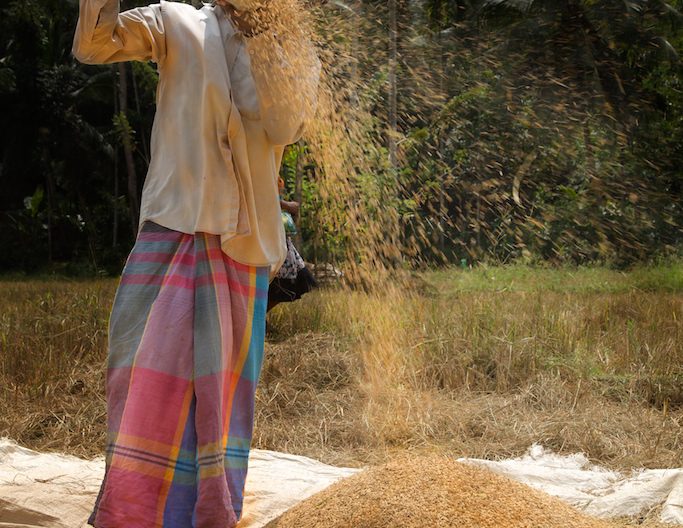
BY ABEBE WOLDEGIORGIS
“To transform the subsistence type of the nation’s agriculture in to modern one, proper utilization of inputs is not questionable. One of the vital components of agricultural inputs is selected seeds,” Umer Hussein, Minister of Agriculture said.
On a public gathering held recently the Minister said that though agriculture is the main stay of the country’s economy, most of the inputs including fertilizer, pesticides, herbicides and selected seeds are imported from abroad and such situation for the nation which critically suffers from shortage of hard currency is unbearable. Therefore, substituting particularly the imported selected seeds by local one should be taken as a way out.
As to him, seed is a mark of the continuation of crops generation so that without it, discontinuity of crops might occur and gradually disappearance may happen.
Getu Gemechu, an agricultural researcher for his part said that to utilize seeds effectively and efficiently the distribution process of the selected seeds must be conducted in its own system.
Currently, misconducts are witnessed in the distributions process and some supplies to farmers even include spoiled seeds which brings its own drawback on the agricultural production. Besides, ill preserved seeds have their own consequence on human health. Hence, to contain such misconduct practice, a functioning seed spreading system is vital.
The authority to inspect and supervise the distribution of selected seeds is given to the Ministry of Agriculture but due to the obsolete nature of the department, it is unable to deliver its responsibility with the collaboration of the pertinent stake holders. moreover, no one showed interest to own the job.
For the last successive decades, Ethiopia has strived to attain food security through improving the sector but the effort left in vain. Among the factors responsible for not achieving the goal is the absence of supplying sufficient inputs particularly selected seeds.
As to Getu, in order to modernize the nation’s seed distribution many researches are conducted and the possible solutions were forwarded but no one dared to implement it. Unless the usual approach of seed distribution is changed, achieving raising productivity is a nightmarish.
Therefore, crafting new strategy for the Ethiopian Selected Seed Organization and supporting by finance, science and technology could help to attain its objectives.
The seed system studies were conducted by various professionals and some remedial solutions were forwarded. Among the very challenging factors the system encountered is that, there is duplication of efforts by stake holders. Actors are not playing a defined role and similar steps and measures have not been taken by stake holders which in turn wasted time, money and energy.
Therefore, giving specific responsibilities to seed reproducers with exclusive rights might reduce effort duplication. Preserving basic seeds should be a priority agenda and sufficient information is available in this regard. Reproducing basic seeds lasts up to four years but the work should be done cautiously.
Studies indicated that, before sawing seeds, knowing the steps of research and keeping the quality is essential. The land utilized for seed reproduction should also be well prepared.
According to the Minister of Agriculture, seed reproduction needs working diligently because if wrongly conducted, its repercussion affects the whole production system. In addition, the work should be done timely because delay harms the production process.
Dawit Alemu is also an agricultural researcher specialized on seed reproduction. As to him, the government consistently emphasizes to raise agricultural productivity, growth and ensuring food security in its long-term development strategy. Key components of the strategy are increasing access to modern inputs and extension services for the country largely small holder based agricultural sector.
He further said that over the past two decades, decision makers in Ethiopia have pursued a range of policies particularly with respect to stable food crops that are critical in reducing poverty in the rural parts of the country.
The central aim of the process has been to increase the availability of improved seeds, chemical fertilizer and extension service. Although there are some evidences to suggest that the process has been led to improvements in both input and yields during this period, decision makers still recognize that there is a wide room for improvement.
According to the renowned land researcher Dsalegn Rahmato, the first agricultural integrated extension program was implemented by the imperial regime in 1970s.The program focused on the promotion of supplying modern inputs, credit and extension services and the formation of cooperative societies and these were highlighted by areas development program in the places such as the Chilalo Agricultural Unit, the Wolayta Agricultural Development Unit and the Ada’s District Development Project.
Although these programs helped to develop Ethiopia’s expertise in agricultural intensification, their scale was very small to boost output and productivity. Thus by the end of the imperial era, Ethiopia’s extension services reached only about 16 percent of the farming population, while input and credit provision catered largely to the feudal classes rather than the small holders population engaged in food production.
The first minimum package program attempted to expand access to modern inputs such as improved seeds and fertilizer while simultaneously reduced the level and cost of services provided to small holders. A minimum package area comprised about 10000 house hold farmers residing along a main all weather road for 50- 75 kilo meters and away from the road for 5 -10 kilometers on both sides.
Although the program was designed during the imperial era, its implementation continued in to the military Dergue regime that followed the downfall of the old regime. During this time the land was nationalized by abolishing the feudal land holding system.
However, state monopolization of land again highly reduced reaching farmers with modern inputs.
As mentioned above, the utilization of modern inputs is key for rising agricultural productivity and since the imperial era various measures have been taken to reach farmers with better inputs but the scale of the amount and the coverage areas is small as compared to the cultivated areas. Hence strengthening the supply of inputs should continue.
The Ethiopian Herald April 14/2021





